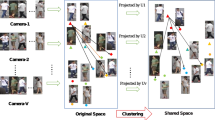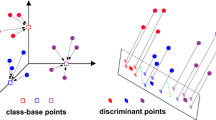Abstract
Unsupervised person re-identification(person Re-ID) based on traditional asymmetric metric learning faces the problems of data distribution differences and feature nonlinearity caused by uncontrolled collection of pedestrian images. To solve these problems, an unsupervised person re-identification method based on asymmetric metric learning with kernel distribution constraints is proposed. Firstly, the data distribution constraint is introduced into asymmetric metric learning, and the mean difference between samples is calculated by using the maximum mean difference term. This metric method effectively overcomes the problem of distribution differences in different sample data features caused by scene changes. Secondly, the Gaussian kernel function is introduced into asymmetric metric learning based on data distribution constraints, and pedestrian samples are mapped to high-dimensional space through nonlinear mapping. This method overcomes the problem of linear inseparability of pedestrian features, while avoiding the high dimensionality of features and reducing computational complexity. Finally, the optimal metric matrix is obtained by solving the generalized eigenvalue problem. Extensive experiments are conducted on five datasets: VIPeR, PRID450S, CHUK01, Market-1501, and DukeMTMC-reID. The experimental results of comparison with other methods show that our method achieves competitive performance.
This work is supported by Natural Science Foundation of Shandong Province (ZR2022MF307).
Access this chapter
Tax calculation will be finalised at checkout
Purchases are for personal use only
Similar content being viewed by others
References
Ali, T.F., Chaudhuri, S.: Cross-view kernel similarity metric learning using pairwise constraints for person re-identification. In: Proceedings of the Twelfth Indian Conference on Computer Vision, Graphics and Image Processing, pp. 1–9 (2021)
Baohua, Z., Siyu, Z., Yufeng, Z., Xiaoqi, L., Yu, G., Jianjun, L., Xin, L.: A novel unsupervised person re-identification algorithm based on soft multi-label and compound attention model. Multimed. Tools Appl. 81(17), 24081–24098 (2022)
Chen, G., Zou, G., Liu, Y., Zhang, X., Fu, G.: Few-shot person re-identification based on feature set augmentation and metric fusion. Eng. Appl. Artif. Intell. 125, 106761 (2023)
Chen, Y.C., Zheng, W.S., Lai, J.H., Yuen, P.C.: An asymmetric distance model for cross-view feature mapping in person reidentification. IEEE Trans. Circuits Syst. Video Technol. 27(8), 1661–1675 (2016)
He, W.X., Chen, Y.C., Lai, J.H.: Cross-view transformation based sparse reconstruction for person re-identification. In: 2016 23rd International Conference on Pattern Recognition (ICPR), pp. 3410–3415. IEEE (2016)
Kodirov, E., Xiang, T., Gong, S.: Dictionary learning with iterative laplacian regularisation for unsupervised person re-identification. In: BMVC, vol. 3, p. 8 (2015)
Koestinger, M., Hirzer, M., Wohlhart, P., Roth, P.M., Bischof, H.: Large scale metric learning from equivalence constraints. In: 2012 IEEE Conference on Computer Vision and Pattern Recognition, pp. 2288–2295. IEEE (2012)
Lee, H., Ekanadham, C., Ng, A.: Sparse deep belief net model for visual area v2. Adv. Neural Inf. Process. Syst. 20 (2007)
Li, M., Zhu, X., Gong, S.: Unsupervised tracklet person re-identification. IEEE Trans. Pattern Anal. Mach. Intell. 42(7), 1770–1782 (2019)
Liao, S., Hu, Y., Zhu, X., Li, S.Z.: Person re-identification by local maximal occurrence representation and metric learning. In: Proceedings of the IEEE Conference on Computer Vision and Pattern Recognition, pp. 2197–2206 (2015)
Liu, Y., Zou, G., Chen, G., Gao, M., Yin, L.: Unsupervised person re-identification based on distribution regularization constrained asymmetric metric learning. Appl. Intell. 53(23), 28879–28894 (2023)
Nguyen, B., De Baets, B.: Kernel distance metric learning using pairwise constraints for person re-identification. IEEE Trans. Image Process. 28(2), 589–600 (2018)
Pedagadi, S., Orwell, J., Velastin, S., Boghossian, B.: Local fisher discriminant analysis for pedestrian re-identification. In: Proceedings of the IEEE Conference on Computer Vision and Pattern Recognition, pp. 3318–3325 (2013)
Prates, R., Oliveira, M., Schwartz, W.R.: Kernel partial least squares for person re-identification. In: 2016 13th IEEE International Conference on Advanced Video and Signal Based Surveillance (AVSS), pp. 249–255. IEEE (2016)
Qin, C., Song, S., Huang, G., Zhu, L.: Unsupervised neighborhood component analysis for clustering. Neurocomputing 168, 609–617 (2015)
Tao, X., Kong, J., Jiang, M., Liu, T.: Unsupervised domain adaptation by multi-loss gap minimization learning for person re-identification. IEEE Trans. Circuits Syst. Video Technol. 32(7), 4404–4416 (2021)
Wang, M., Lai, B., Huang, J., Gong, X., Hua, X.S.: Camera-aware proxies for unsupervised person re-identification. In: Proceedings of the AAAI Conference on Artificial Intelligence, vol. 35, pp. 2764–2772 (2021)
Xiong, F., Gou, M., Camps, O., Sznaier, M.: Person re-identification using kernel-based metric learning methods. In: Fleet, D., Pajdla, T., Schiele, B., Tuytelaars, T. (eds.) Computer Vision – ECCV 2014. ECCV 2014. Lecture Notes in Computer Science, vol. 8695. Springer, Cham (2014). https://doi.org/10.1007/978-3-319-10584-0_1
Yu, H.X., Wu, A., Zheng, W.S.: Cross-view asymmetric metric learning for unsupervised person re-identification. In: Proceedings of the IEEE International Conference on Computer Vision, pp. 994–1002 (2017)
Zhang, X., Li, D., Wang, Z., Wang, J., Ding, E., Shi, J.Q., Zhang, Z., Wang, J.: Implicit sample extension for unsupervised person re-identification. In: Proceedings of the IEEE/CVF Conference on Computer Vision and Pattern Recognition, pp. 7369–7378 (2022)
Author information
Authors and Affiliations
Corresponding author
Editor information
Editors and Affiliations
Rights and permissions
Copyright information
© 2025 The Author(s), under exclusive license to Springer Nature Singapore Pte Ltd.
About this paper
Cite this paper
Liu, Y., Chen, G., Chen, Y., Fu, G., Zou, G. (2025). Unsupervised Person Re-ID Based on Nonlinear Asymmetric Metric Learning. In: Lin, Z., et al. Pattern Recognition and Computer Vision. PRCV 2024. Lecture Notes in Computer Science, vol 15045. Springer, Singapore. https://doi.org/10.1007/978-981-97-8499-8_36
Download citation
DOI: https://doi.org/10.1007/978-981-97-8499-8_36
Published:
Publisher Name: Springer, Singapore
Print ISBN: 978-981-97-8498-1
Online ISBN: 978-981-97-8499-8
eBook Packages: Computer ScienceComputer Science (R0)




